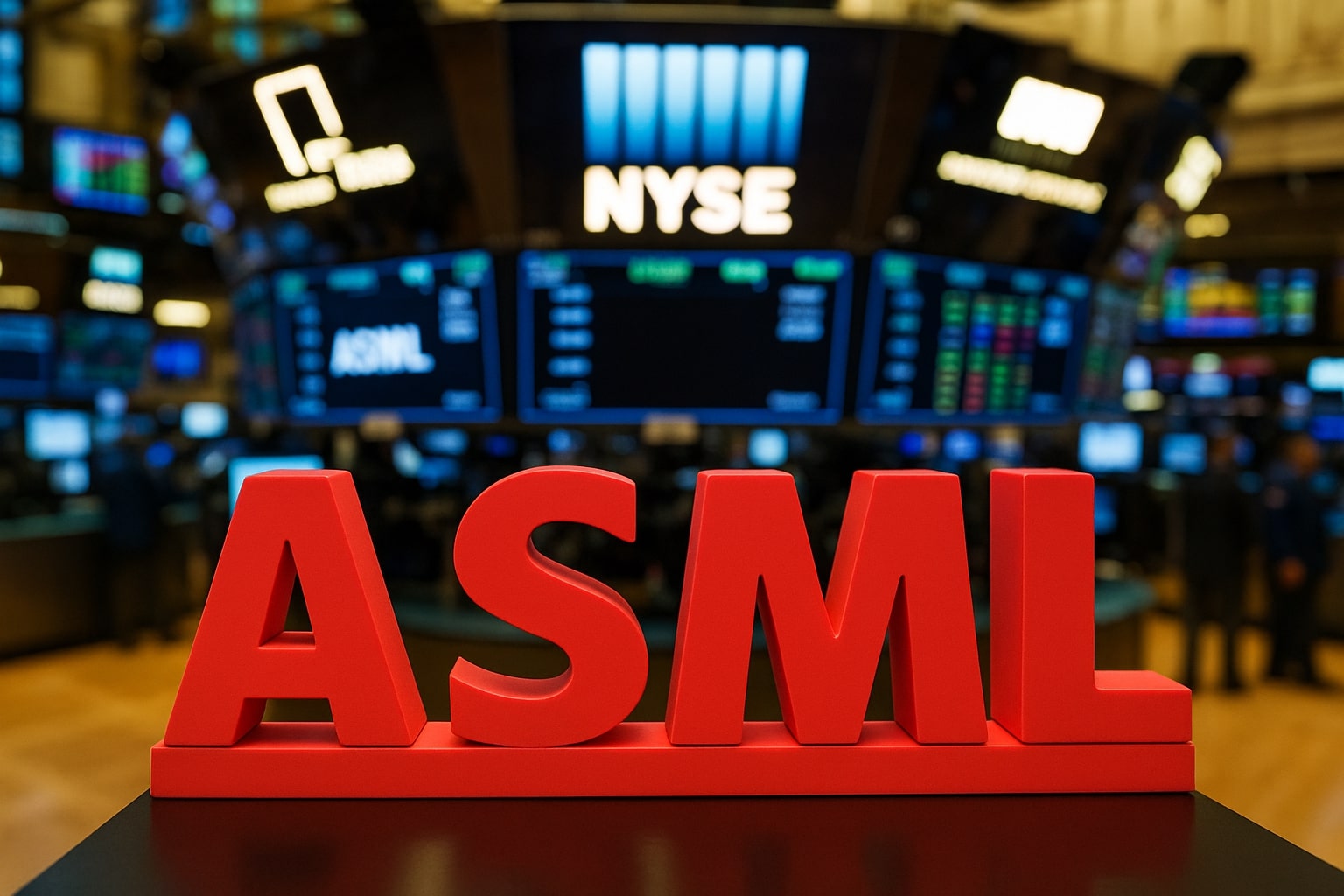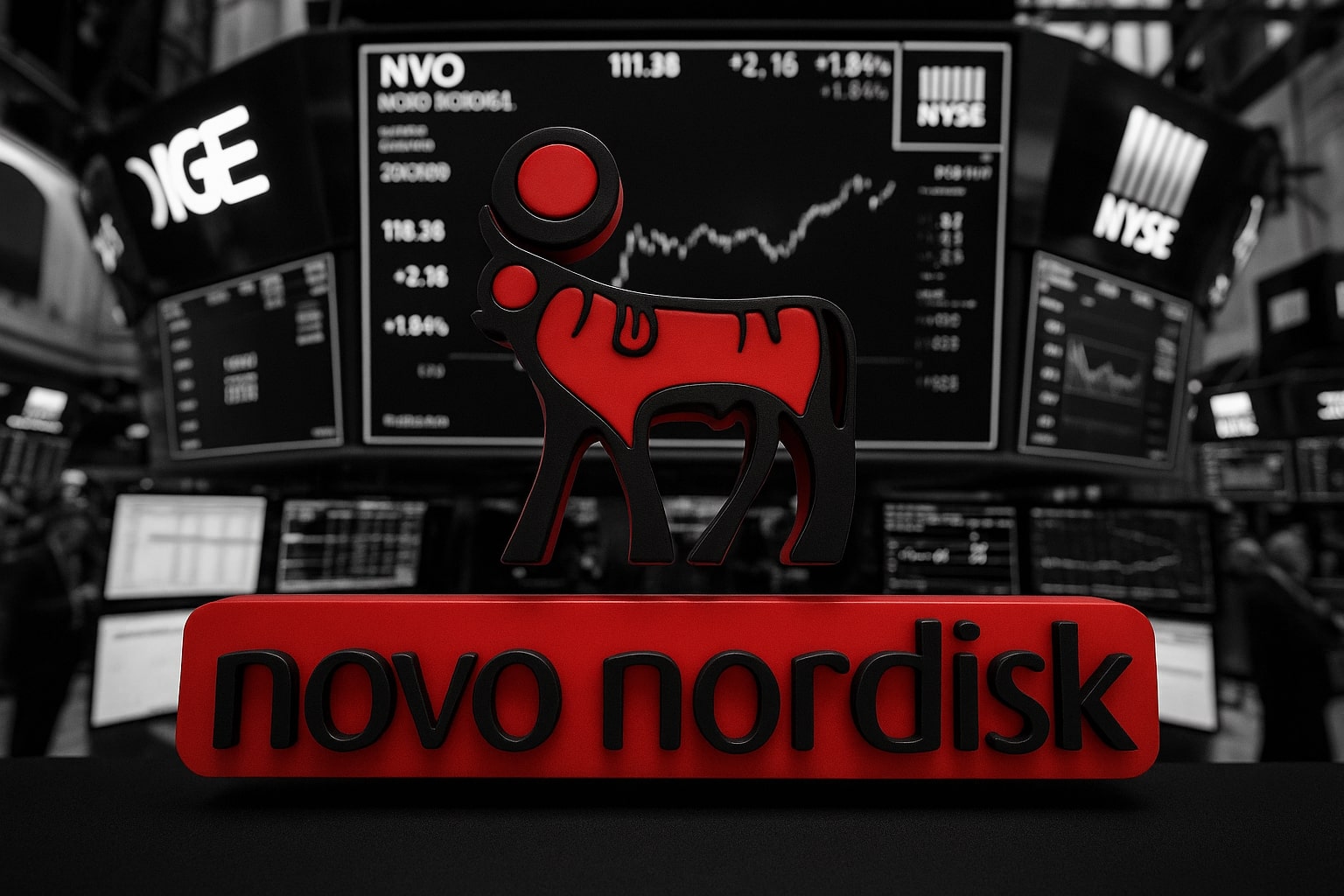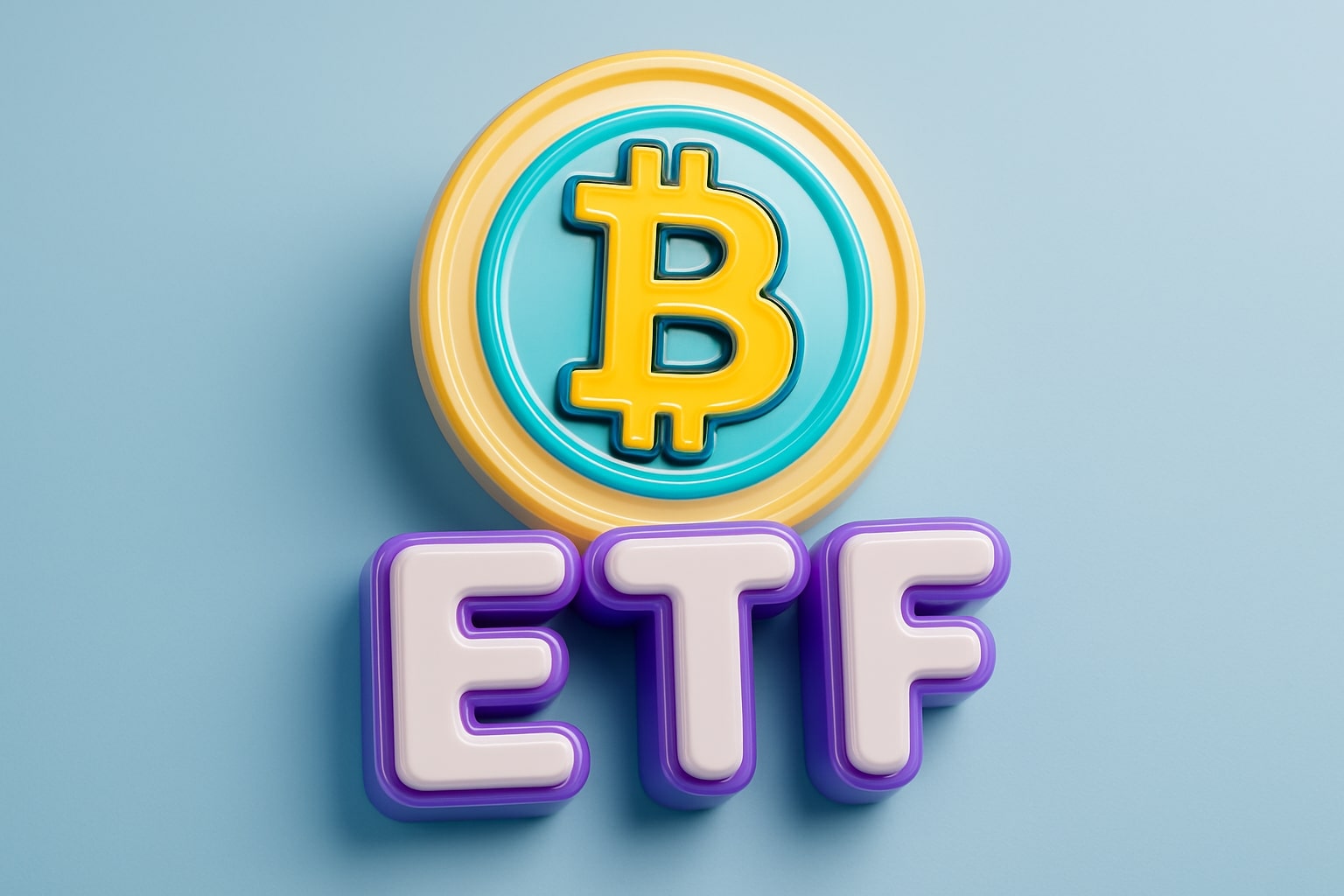
ASML Stock Price Forecast - ASML Breaks $1,000 as Record €5.4B Bookings Cement AI-Era Leadership
ASML delivers €7.52B in Q3 revenue and 51.6% gross margin as High-NA systems and €32.5B FY2025 outlook reaffirm its monopoly in global chipmaking despite China export curbs | That's TradingNEWS
ASML (NASDAQ:ASML) Reaffirms Global Semiconductor Dominance as Q3 Results Signal Record AI Demand and High-NA Breakthrough
Unrivaled Position in AI Infrastructure and Lithography Leadership
ASML Holding N.V. (NASDAQ:ASML) solidified its position as the linchpin of global semiconductor production with Q3 results that showcased the company’s unmatched pricing power, technological monopoly, and pivotal role in the AI-driven chip boom. Shares surged above $1,001.62, marking a +40% YTD rally, as investors reassessed ASML’s growth visibility through 2026. Despite a €210 million top-line miss, the company delivered €7.52 billion in quarterly revenue, €5.48 EPS, and an impressive 51.6% gross margin, surpassing expectations on profitability and bookings quality.
ASML’s €5.4 billion in net bookings, up +104.9% year-over-year, underscored the firm’s dominance in extreme ultraviolet (EUV) lithography systems, which remain indispensable for next-generation AI processors and advanced nodes. Demand from leading foundries—Taiwan Semiconductor (NYSE:TSM), Intel (NASDAQ:INTC), and Samsung Electronics—continues to accelerate, powered by global capex expansion from AI hyperscalers including Amazon (NASDAQ:AMZN), Microsoft (NASDAQ:MSFT), and Google (NASDAQ:GOOGL).
AI Megadeals and the Semiconductor Supercycle
ASML’s growth momentum is inseparable from the ongoing OpenAI megadeals, which have unleashed a historic investment wave across the chip supply chain. The ripple effect of NVIDIA’s $100 billion commitment to OpenAI and AMD’s (NASDAQ:AMD) $34.6 billion warrant issuance to support 6-GW GPU deployments directly benefits ASML, the only supplier capable of manufacturing the EUV machines that enable those chips.
The Semiconductor Industry Association reported a +21.7% YoY surge in global chip sales in August 2025, validating that the multi-year AI infrastructure cycle remains in its early innings. ASML’s role is irreplaceable: each EUV system, priced between $200 million and $350 million, contains over 450,000 components and requires 5,000 suppliers, making it a barrier to entry that no competitor—including Nikon or Canon—has breached.
Record Q3 Performance and Strategic Resilience
ASML’s Q3 reflected both cyclical discipline and secular growth strength. Total lithography sales reached €5.55 billion, while the Installed Base Management division expanded +27.2% YoY to €1.96 billion, supported by ongoing servicing revenue from its growing EUV footprint. The company’s razor-and-blade business model continues to drive recurring margins, with maintenance and software upgrades contributing nearly €2 billion per quarter.
Operating income hit €2.47 billion, while the interim dividend of €1.60 per share, payable on November 6, 2025, and a new 2026 buyback program reaffirmed shareholder alignment. Free cash flow was slightly softer than expected, yet still solid, driven by disciplined capex and strong collections from high-margin orders.
Shift Toward Memory Market Strength and High-NA Expansion
A critical development in Q3 was the transformation in ASML’s bookings mix. Memory orders rebounded sharply, signaling the recovery of the DRAM and HBM markets. Memory now accounts for roughly one-third of ASML’s system sales and is set to expand as hyperscalers scale storage capacity for AI workloads. Logic remains dominant, representing about two-thirds of sales, but the increasing diversification into memory reduces cyclicality.
Management confirmed that customers have already processed over 300,000 wafers using new High-NA EUV machines, which are far more mature at this stage than prior-generation Low-NA models. The High-NA systems, costing around $350 million each, will enable 2nm and sub-2nm chip production for TSMC’s Arizona fabs and Intel’s next-gen platforms. This leap from 2D to 3D integration allows for vertical transistor stacking—an innovation that could redefine Moore’s Law for the AI era.
Geopolitical Headwinds and China Exposure
China remains ASML’s second-largest market, accounting for up to 41% of system sales in Q3, compared to 27% in the prior quarter. While this lifted margins, management reiterated that 2026 China revenues will decline significantly due to tightening export restrictions on EUV and ArFi lithography tools. ASML can still sell older DUV systems and maintain existing installations, but new advanced systems are restricted under U.S. policy.Nevertheless, demand redirection toward the U.S., Europe, and Japan offsets the China slowdown. TSMC’s Arizona fabs—now ramping up N4 and N3 nodes—and Micron’s (NASDAQ:MU) new DRAM facilities in the U.S. and Japan ensure ASML’s global diversification remains intact. With global foundries investing hundreds of billions in AI capacity, ASML’s bookings pipeline stays fully loaded through 2027.
Read More
-
SCHD ETF Holds Ground With 3.6% Yield as Dividend Investors Eye Stability Over Growth
15.10.2025 · TradingNEWS ArchiveStocks
-
Ripple XRP (XRP-USD) Steadies at $2.43- SEC Shutdown Freezes ETF Decisions, Inflows Hit $61.6M
15.10.2025 · TradingNEWS ArchiveCrypto
-
NG=F Falls to $2.99 as Record Supply Outpaces Demand Despite 16.9 Bcf/d LNG Exports
15.10.2025 · TradingNEWS ArchiveCommodities
-
USD/JPY Price Forecast - Yen Weakens to 151.30 Amid Dollar Selloff
15.10.2025 · TradingNEWS ArchiveForex
Technological Monopolies and Strategic Investments
ASML’s integration of AI into its own operations is deepening. The company’s 11% equity stake in Mistral AI, Europe’s leading large language model developer, highlights its ambition to merge semiconductor production with AI-driven optimization. This partnership is expected to accelerate manufacturing precision and automation across its High-NA assembly lines.
The introduction of XT:260 advanced packaging tools for 3D chip stacking further extends ASML’s technological moat. These systems enable higher lithographic intensity per chip, reinforcing ASML’s dominance beyond EUV. Each advancement cements the firm’s status as the indispensable enabler of every major AI and data center build-out worldwide.
Financial Health and Valuation Outlook
ASML trades at a forward P/E of 35.3x and a PEG ratio of 2.01x, slightly above its 5-year average of 1.75x. While valuation appears rich, it remains justified by +40% projected EPS growth in FY2025 and accelerating free cash flow. The firm’s €9 billion FCF in 2024 is expected to exceed €12 billion in 2026 and reach €20 billion by 2030, translating to a free cash flow multiple of 23x for 2026 and 14x for 2030.
Revenue is projected at €32.5 billion for FY2025, growing +15% YoY, with margins anchored above 50%. Analysts see EPS reaching $29.63 next year, implying a fair value near $1,096 if the stock trades at 37x earnings, aligning with ASML’s long-term average.
The balance sheet remains fortress-like, with cash generation supporting consistent dividends and buybacks. Over the past decade, ASML has repurchased roughly 10% of its shares, reflecting disciplined capital allocation.
Macro Risks and Market Psychology
Despite stellar fundamentals, ASML’s shares are 17% below their all-time high, pressured by macro fears of a chip slowdown and U.S.-China trade friction. Short interest has risen +100% YoY, but technicals remain bullish with strong support near $940 and resistance around $1,100. The 200-day moving average trends upward, confirming long-term momentum, while RSI levels show mild overbought conditions—indicative of potential consolidation rather than correction.
China’s demand moderation and export bans remain headline risks, but structural drivers—EUV adoption, AI capex expansion, and High-NA rollouts—far outweigh the cyclical concerns. Each major chip innovation, from NVIDIA’s Blackwell to AMD’s MI450 and Intel’s 2nm roadmap, relies on ASML’s lithography mastery.
ASML’s Strategic Role as the AI Era’s Core Infrastructure
ASML’s significance transcends semiconductors—it is the foundation of the modern digital economy. Without its lithography systems, no chips, GPUs, or AI models could exist. As Agar Capital phrased it, “ASML is the toll booth of the global technology industry.” Every major manufacturer—from TSMC to NVIDIA (NASDAQ:NVDA)—must “pay the toll” through ASML’s machines.
This monopoly is not accidental; it’s the result of 17 years of R&D investment, over $9 billion in development costs, and a 20-year technological head start. It’s a fortress protected by physics, supply chains, and intellectual capital—an unshakable moat that guarantees both demand and pricing power.
Investment Verdict: NASDAQ:ASML – Buy on Strength
ASML’s current valuation near $1,001 per share reflects optimism, not excess. With structural demand from AI, expanding High-NA adoption, and a €5.4B backlog pipeline, the company’s long-term trajectory remains upward. The near-term pullback opportunity lies near $940–$950, a zone aligning with its 50-day moving average and intermediate support trendline.
Considering the combination of robust order visibility, €32.5B FY2025 guidance, and technological monopoly, ASML (NASDAQ:ASML) remains a Buy for long-term investors. The projected price range stands between $1,096 and $1,352 by FY2027, implying +35% to +40% upside potential from current levels, contingent on High-NA execution and continued AI capex growth.
ASML is not a cyclical chip stock—it’s the indispensable toll operator of the AI revolution. Its technology defines the boundaries of computing power, and its earnings power defines the future of the semiconductor market.


















